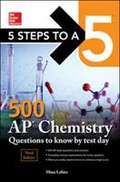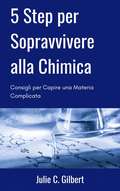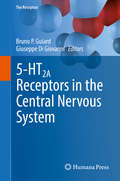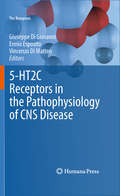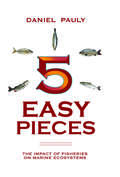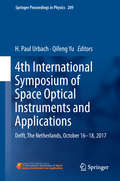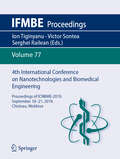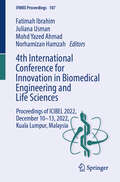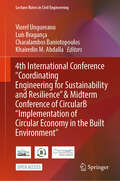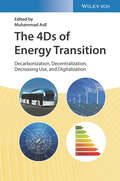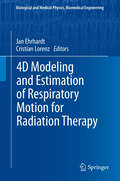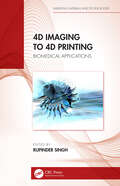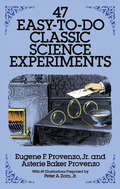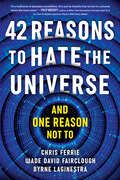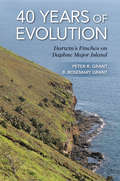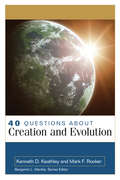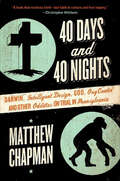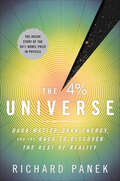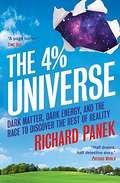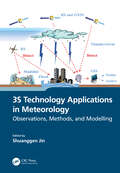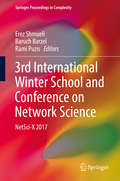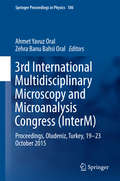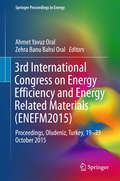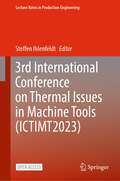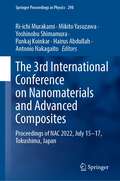- Table View
- List View
5 Steps To A 5: 500 AP Chemistry Questions To Know by Test Day
by Mina LebitzThis book gives 500 practice questions that cover the most essential course material and help you work toward a 5 on the test. The questions parallel the format and degree of difficulty that you’ll find on the actual AP exams and are accompanied by answers with comprehensive explanations.
5 Step per Sopravvivere alla Chimica: Consigli per Capire una Materia Complicata
by Julie C. GilbertHai difficoltà con la chimica? Non sei solo. È facile perdersi nel linguaggio tecnico. Aiuta qualsiasi libro di testo con queste istruzioni per completare i tuoi compiti ed esercizi. Impara tutto quelo che c'è da imparare e magari divertiti anche nel frattempo. Dentro, troverai … • 13 capitoli semplici da leggere divisi per argomento • Istruzioni dettagliate per avere a che fare con la matematica • Trucchi e consigli per capire meglio • Errori comuni da evitare Bonus: Consigli per comunicare in maniera più efficace con il tuo insegnanre “Eccellente esposizione degli argomenti chiave per gli studenti di chimica di tutti i livelli (scuole superiori e università)” ~ David A. Hunt, Ph.D., The College of New Jersey, Professor of Chemistry
5-HT2A Receptors in the Central Nervous System (The Receptors #32)
by Giuseppe Di Giovanni Bruno P. Guiard5-HT2A receptors are G-protein coupled receptors that are widely distributed throughout the brain, most notably on neuronal and glial cells. 5-HT2A receptors have been implicated in various central physiological functions including mood regulation, memory, sleep, nociception, eating, and reward behaviors, and they are also believed to control the cardiovascular system. This book provides a comprehensive overview of these receptors including sections on their properties and distribution, approaches for their study, their role in a number of brain functions and diseases, and their role as therapeutic targets.
5-HT2C Receptors in the Pathophysiology of CNS Disease: 5-ht2c Receptors In The Pathophysiology Of Cns Disease (The Receptors #22)
by Vincenzo Di Matteo Giuseppe Di Giovanni Ennio EspositoPart of Springer's "The Receptors," series, this text is the first ever overview on the research of 5-HT2c receptors. 5-HT2c receptor research has been productive for twenty-five years, but recent years have seen an extraordinary increase in both amount produced and insight gained. 5-HT2c is a prominent central serotonin receptor subtype widely expressed within the central and the peripheral nervous system and is thought to play a key role in the regulation of numerous behaviors. This text covers the molecular, cellular, anatomical, biochemical and behavioral aspects of this receptor, highlighting its distinctive regulatory properties and the emerging functional significance of constitutive activity and RNA-editing in vivo. It also investigates the receptors' therapeutic potential in many diseases, treated individually in separate chapters, including depression, drug abuse, schizophrenia, eating disorders, Parkinson's disease, Prader-Willi Syndrome, Alzheimer's disease and epilepsy.
5 Easy Pieces: The Impact of Fisheries on Marine Ecosystems
by Daniel Pauly5Easy Pieces features five contributions, originally published in Nature and Science, demonstrating the massive impacts of modern industrial fisheries on marine ecosystems. Initially published over an eight-year period, from 1995 to 2003, these articles illustrate a transition in scientific thought--from the initially-contested realization that the crisis of fisheries and their underlying ocean ecosystems was, in fact, global to its broad acceptance by mainstream scientific and public opinion. Daniel Pauly, a well-known fisheries expert who was a co-author of all five articles, presents each original article here and surrounds it with a rich array of contemporary comments, many of which led Pauly and his colleagues to further study. In addition, Pauly documents how popular media reported on the articles and their findings. By doing so, he demonstrates how science evolves. In one chapter, for example, the popular media pick up a contribution and use Pauly's conclusions to contextualize current political disputes; in another, what might be seen as nitpicking by fellow scientists leads Pauly and his colleagues to strengthen their case that commercial fishing is endangering the global marine ecosystem. This structure also allows readers to see how scientists' interactions with the popular media can shape the reception of their own, sometimes controversial, scientific studies. In an epilog, Pauly reflects on the ways that scientific consensus emerges from discussions both within and outside the scientific community.
4th International Symposium of Space Optical Instruments and Applications: Delft, The Netherlands, October 16 -18, 2017 (Springer Proceedings in Physics #209)
by H. Paul Urbach Qifeng YuThis book gathers selected and expanded contributions presented at the 4th Symposium on Space Optical Instruments and Applications, which was held in Delft, the Netherlands, on October 16–18, 2017. This conference series is organized by the Sino-Holland Space Optical Instruments Laboratory, a cooperative platform between China and the Netherlands. The symposium focused on key technological problems regarding optical instruments and their applications in a space context. It covered the latest developments, experiments and results on the theory, instrumentation and applications of space optics. The book is split into five main sections: The first covers optical remote sensing system design, the second focuses on advanced optical system design, and the third addresses remote sensor calibration and measurement. Remote sensing data processing and information extraction are then presented, followed by a final section on remote sensing data applications.
4th International Conference on Nanotechnologies and Biomedical Engineering: Proceedings of ICNBME-2019, September 18-21, 2019, Chisinau, Moldova (IFMBE Proceedings #77)
by Ion Tiginyanu Victor Sontea Serghei RaileanThis book gathers the proceedings of the 4th International Conference on Nanotechnologies and Biomedical Engineering, held on September 18-21, 2019, in Chisinau, Republic of Moldova. It continues the tradition of the previous conference proceedings, thus reporting on both fundamental and applied research at the interface between nanotechnologies and biomedical engineering. Topics include: developments in bio-micro/nanotechnologies and devices; biomedical signal processing; biomedical imaging; biomaterials for biomedical applications; biomimetics; bioinformatics and e-health, and advances in a number of related areas. The book offers a timely snapshot of cutting-edge, multidisciplinary research and developments in the field of biomedical and nano-engineering.
4th International Conference for Innovation in Biomedical Engineering and Life Sciences: Proceedings of ICIBEL 2022, December 10–13, 2022, Kuala Lumpur, Malaysia (IFMBE Proceedings #107)
by Fatimah Ibrahim Juliana Usman Mohd Yazed Ahmad Norhamizan HamzahThis book reports on engineering methods and technologies for biomedical applications. It covers sensors and devices for biological and medical purposes, along with their fabrication and testing, and advances in engineering technologies, such as autonomous systems, which can support life science and healthcare in the era of industry 4.0. Based on the proceedings of the 4th International Conference for Innovation in Biomedical Engineering and Life Sciences, ICIBEL 2022, held on December 10–13, 2022, in Kuala Lumpur, Malaysia, this book provides researchers and professionals with a timely snapshot of current issues and challenges in the broad field of biomedical engineering. It is aimed at inspiring future research and fostering interdisciplinary and international collaborations in this field and relating ones.
4th International Conference "Coordinating Engineering for Sustainability and Resilience" & Midterm Conference of CircularB “Implementation of Circular Economy in the Built Environment” (Lecture Notes in Civil Engineering #489)
by Viorel Ungureanu Luís Bragança Charalambos Baniotopoulos Khairedin M. AbdallaThis open access book gathers the proceedings of the 4th International Conference “Coordinating Engineering for Sustainability and Resilience” (CESARE) & Midterm Conference of CircularB “Implementation of Circular Economy in the Built Environment”, held in Timișoara, Romania, on May 29-31, 2024, as part of the COST Action CA21103. The volume represents the state of the art of sustainability and resilience in modern and future built environment, constructions, and infrastructure, and includes topics such as structural materials and robustness, fire engineering, risk assessment, impact of climate change on the built environment, sustainable resilience of systems in the built environment, smart cities, circular economy, design strategies for product design, integration of renewable energy at building and small urban area scales, restoration & rehabilitation of historical buildings, sustainable infrastructures, wind energy structures, façade engineering, green buildings, and waste management.
The 4Ds of Energy Transition: Decarbonization, Decentralization, Decreasing Use, and Digitalization
by Muhammad AsifThe 4Ds of Energy Transition Enables readers to understand technology-driven approaches that address the challenges of today’s energy scenario and the shift towards sustainable energy transition This book provides a comprehensive account of the characteristics of energy transition, covering the latest advancements, trends, and practices around the topic. It charts the path to global energy sustainability based on existing technology by focusing on the four dynamic approaches of decarbonization, decreasing use, decentralization, and digitalization, plus the important technical, economic, social and policy perspectives surrounding those approaches. Each technology is demonstrated with an introduction and a set of specific chapters. The work appropriately incorporates up-to-date data, case studies, and comparative assessments to further aid in reader comprehension. Sample topics discussed within the work by key thinkers and researchers in the broader fields of energy include: Renewable energy and sustainable energy future Decarbonization in energy sector Hydrogen and fuel cells Electric mobility and sustainable transportation Energy conservation and management Distributed and off-grid generation, energy storage, and batteries Digitalization in energy sector; smart meters, smart grids, blockchain This book is an ideal professional resource for engineers, academics, and policy makers working in areas related to the development of energy solutions.
4D Modeling and Estimation of Respiratory Motion for Radiation Therapy (Biological and Medical Physics, Biomedical Engineering)
by Cristian Lorenz Jan EhrhardtRespiratory motion causes an important uncertainty in radiotherapy planning of the thorax and upper abdomen. The main objective of radiation therapy is to eradicate or shrink tumor cells without damaging the surrounding tissue by delivering a high radiation dose to the tumor region and a dose as low as possible to healthy organ tissues. Meeting this demand remains a challenge especially in case of lung tumors due to breathing-induced tumor and organ motion where motion amplitudes can measure up to several centimeters. Therefore, modeling of respiratory motion has become increasingly important in radiation therapy. With 4D imaging techniques spatiotemporal image sequences can be acquired to investigate dynamic processes in the patient's body. Furthermore, image registration enables the estimation of the breathing-induced motion and the description of the temporal change in position and shape of the structures of interest by establishing the correspondence between images acquired at different phases of the breathing cycle. In radiation therapy these motion estimations are used to define accurate treatment margins, e.g. to calculate dose distributions and to develop prediction models for gated or robotic radiotherapy. In this book, the increasing role of image registration and motion estimation algorithms for the interpretation of complex 4D medical image sequences is illustrated. Different 4D CT image acquisition techniques and conceptually different motion estimation algorithms are presented. The clinical relevance is demonstrated by means of example applications which are related to the radiation therapy of thoracic and abdominal tumors. The state of the art and perspectives are shown by an insight into the current field of research. The book is addressed to biomedical engineers, medical physicists, researchers and physicians working in the fields of medical image analysis, radiology and radiation therapy.
4D Imaging to 4D Printing: Biomedical Applications (Emerging Materials and Technologies)
by Rupinder SinghThis book focuses on applications of 4D imaging and 4D printing for development of low-cost, indigenous lab-scale solutions for various biomedical applications. It is based on a selection of benchmark open-source 4D imaging solutions including the effect of different stimulus (such as light, electric field, magnetic field, mechanical load, thermal, hydro, and so forth) to better understand 4D capabilities of printed components. The material is covered across nine chapters dedicated to 4D imaging, 4D printing, and their specific biomedical applications illustrated via case studies related to orthopaedic and dental requirements of veterinary patients. The book: •Presents exclusive material on the integration of 4D imaging and 4D printing•Demonstrates the industrial applications of 4D imaging in 4D printing using multiple case studies•Discusses use of open-source 4D imaging tools for biomedical applications•Includes in-house development of smart materials for 4D printing•Reviews low-cost, indigenous lab-scale solutions for various veterinary applications. This book is aimed at graduate students and researchers in Additive Manufacturing, Manufacturing Engineering, Production Engineering, Mechanical Engineering, and Materials Engineering.
47 Easy-to-Do Classic Science Experiments (Dover Children's Science Books)
by Eugene F. Provenzo Jr. Asterie Baker ProvenzoHere is a highly motivating book for grade-school students that will introduce them to many of the world's most popular (and historically significant) scientific experiments. They'll learn about gravity simply by following the acrobatic antics of an ordinary coin. By trying to blow an egg out of a cup, they'll discover the principles of air pressure. Dancing soap bubbles will help them understand the effects of static electricity, and by dropping quarters into a full glass of water without causing it to overflow, they'll study the effects of surface tension.These and over 40 other experiments have been carefully selected by noted educators Eugene and Asterie Baker Provenzo to familiarize children with classic science experiments involving optics, inertia, air pressure, magnetism, sound, topology, light, density, vibration, prisms, elasticity, gases, vacuum, perspective, geometry, centrifugal force, buoyancy, color, and much more. Some experiments, such as the optical "Newton's Rings" are hundreds of years old. Still others, like the straw lever test, are based on Greek experiments with leverage and the center of gravity -- first carried out thousands of years ago.Easy-to-follow instructions and illustrations show youngsters how to perform each experiment, most of which are prefaced with historical background, a list of necessary materials and an explanation of key terms. Almost all experiments can be carried out with common household items (tissue paper, scissors, tapes, rubber balloons, pens, pencils, etc.) and can be worked at home or in the classroom to demonstrate specific scientific principles or to supplement a science-curriculum unit. Sources for all historical illustrations given in the text are listed at the end of the book.
42 Reasons to Hate the Universe: (And One Reason Not To)
by Chris Ferrie Wade David Fairclough Byrne LaGinestraIf you've always suspected the universe was out to get you… you were right!Yes, the universe we live in is cosmically beautiful and mysterious and all that crap. But it's also a bit of an asshole. After all, remember that you are just a group of atoms structured in a specific way for barely long enough to try to understand this thing we call existence. Those atoms could just have easily been used to make the dog shit you're cleaning off your shoe or the mold that grows on your bread! The fact is, when you zoom out to look at the universe and how it functions, you'll see that it's usually not in our favor, and many of the laws of physics are actively working against our survival. In this book, you'll discover why:You're an aging mutantInvisible rays are melting our genetic codeThe Earth is covered in explosive pimplesLiterally everything is poisonousAnd more true and terrifying scientific facts!But don't worry! While it's true that there are (at least) forty-two grudges to hold against the universe, the good news is that there is also one very good reason to forgive them all and embrace the wild, improbable fact that we are alive (for now) and we should take advantage of it while we can. 42 Reasons to Hate the Universe (And One Reason Not To) is a hilarious, no-holds-barred exploration of all the reasons we shouldn't exist—but somehow do anyway. Rooted in scientific research but written simply so that evolved apes such as ourselves can understand where the heck we came from and where we're likely going, this book is for all the nerds and nihilists who know they're going down in the end but want to enjoy the rollercoaster ride of existence on the way.
40 Years of Evolution: Darwin's Finches on Daphne Major Island
by Peter R. Grant B. Rosemary GrantAn important look at a groundbreaking forty-year study of Darwin's finchesRenowned evolutionary biologists Peter and Rosemary Grant have produced landmark studies of the Galápagos finches first made famous by Charles Darwin. In How and Why Species Multiply, they offered a complete evolutionary history of Darwin's finches since their origin almost three million years ago. Now, in their richly illustrated new book, 40 Years of Evolution, the authors turn their attention to events taking place on a contemporary scale. By continuously tracking finch populations over a period of four decades, they uncover the causes and consequences of significant events leading to evolutionary changes in species.The authors used a vast and unparalleled range of ecological, behavioral, and genetic data—including song recordings, DNA analyses, and feeding and breeding behavior—to measure changes in finch populations on the small island of Daphne Major in the Galápagos archipelago. They find that natural selection happens repeatedly, that finches hybridize and exchange genes rarely, and that they compete for scarce food in times of drought, with the remarkable result that the finch populations today differ significantly in average beak size and shape from those of forty years ago. The authors' most spectacular discovery is the initiation and establishment of a new lineage that now behaves as a new species, differing from others in size, song, and other characteristics. The authors emphasize the immeasurable value of continuous long-term studies of natural populations and of critical opportunities for detecting and understanding rare but significant events.By following the fates of finches for several generations, 40 Years of Evolution offers unparalleled insights into ecological and evolutionary changes in natural environments.
40 Questions About Creation and Evolution (40 Questions & Answers Series)
by Kenneth Keathley Mark F. RookerBiblically and scientifically informed answers to pressing questions about the creation-evolution debateThis accessible volume evenly addresses the issues of modern science and the scriptural texts. The conservative evangelical authors are well-informed on contemporary scientific views of the universe and also carefully exegete the biblical texts that pertain to creation. They irenically consider the various angles of the debate and make constructive suggestions to reconcile science and the Bible.Those who are curious about the origins of life and the universe will want to read this book. Seminary students and serious college students will find this information critical, as an understanding of creation is vital to an effective apologetic in sharing the faith.
40 Days and 40 Nights: Darwin, Intelligent Design, God, Oxycontin®, and Other Oddities on Trial in Pennsylvania
by Matthew ChapmanIn this fascinating story of evolution, religion, politics, and personalities, Matthew Chapman captures the story behind the headlines in the debate over God and science in America.Kitzmiller v. Dover Board of Education, decided in late 2005, pitted the teaching of intelligent design (sometimes known as "creationism in a lab coat") against the teaching of evolution. Matthew Chapman, the great-great-grandson of Charles Darwin, spent several months covering the trial from beginning to end. Through his in-depth encounters with the participants—creationists, preachers, teachers, scientists on both sides of the issue, lawyers, theologians, the judge, and the eleven parents who resisted the fundamentalist proponents of intelligent design—Chapman tells a sometimes terrifying, often hilarious, and above all moving story of ordinary people doing battle in America over the place of religion and science in modern life.
The 4% Universe: Dark Matter, Dark Energy, and the Race to Discover the Rest of Reality
by Richard Panek"The centerpiece of The 4% Universe is a compelling narrative of science at its best… serve[s] handsomely as an illuminating guide to the dark mysteries lying at the heart of the intersection of astronomy and fundamental physics."—The Wall Street Journal "Impeccably researched and highly readable."—New Scientist "A model for all would-be popular-science writers."—Physics World "Panek's passion for the mysteries of dark matter and dark energy wins the day. He succeeds because he recognizes that he's writing not just about red shifts and supernovae, but about people...the success of The 4 Percent Universe also stems from Panek's wisdom about how science works."—The Washington Post "The balance between lively characters and provocative ideas keeps the book moving as quickly as any high stakes thriller, but the pay-off here is an answer of truly cosmic significance...the universe is keeping secrets from us--big secrets. Dark secrets. Panek's joyful journey through the wilds of modern cosmology gives us good reason to care about those secrets, and their sure-to-be surprising answers."—Ad Astra, Magazine of National Space Society"A superior account of how astronomers discovered that they knew almost nothing about 96 percent of the universe. Science writer Panek (The Invisible Century: Einstein, Freud, and the Search for Hidden Universes, 2005, etc.) points out that 50 years ago astronomers assumed they understood the cosmos and its history from the big bang to galaxy formation to its ultimate fate as expansion continued. One detail remained disturbing: Galaxies were moving too fast. Since gravity controls movements, they had to be heavier than predicted. By the 1980s, this "missing mass" problem became critical as it became clear that galaxies, including ours, were rotating so fast that missing mass far outweighs visible objects such as stars. Even after eliminating gas and dust, "dark matter" represents strange particles unknown to science. Astronomers also believed that gravity was slowing expansion of the universe but debated if galaxies would reverse themselves, continue to recede ever more slowly or (the favorite theory) simply stop. Panek describes frustrating struggles with high-tech detectors, complex computer algorithms and massive telescopes to search distant galaxies for the key. The answer came in the late '90s expansion wasn't slowing but speeding up. Flabbergasted astronomers understood that accelerating billions of galaxies requires immense energy. Since Einstein proved that energy and mass are equivalent, this "dark energy" makes up three-quarters of the universe. Dark energy added to dark matter reduces the familiar universe to 4 percent of the total. Panek delivers vivid sketches of scientists, lucid explanations of their work and revealing descriptions of the often stormy rivalry that led to this scientific revolution, usually a media cliche, but not in this case." —Kirkus Reviews, STARRED review"There has always been more to the universe than we can see. Science journalist Panek (The Invisible Century) offers an insider's view of the quest for what could be the ultimate revelation: the true substance of the unseen dark matter and energy that makes up some 96% of our universe. The search for these hidden elements began in the 1960s with astronomers asking whether the universe would end in an infinitely expanding "Big Chill" or a collapse into a "Big Crunch"--or whether the universe is a just-right "Goldilocks" space that would nurture stars and galaxies forever. To answer this question, scientists calculated the universe's mass and discovered there was far more mass than we could see. But where is this "missing mass" and what kind of exotic "dark" stuff is it made of? Panek gleefully describes a 'Wild West of the mind, where —
The 4-Percent Universe: Dark Matter, Dark Energy, and the Race to Discover the Rest of Reality
by Richard PanekIt is one of the most disturbing aspects of our universe: only four per cent of it consists of the matter that makes up every star, planet, and every book. The rest is completely unknown. Acclaimed science writer Richard Panek tells the story of the handful of scientists who have spent the past few decades on a quest to unlock the secrets of "dark matter" and the even stranger substance called "dark energy". These are perhaps the greatest mysteries in science,and solving them will reshape our understanding of the universe and our place in it. The stakes could not be higher. Panek's fast-paced narrative, filled with original, in-depth reporting and intimate, behind-the-scenes details, brings this epic story to life for the very first time.
3S Technology Applications in Meteorology: Observations, Methods, and Modelling
by Shuanggen JinSpatial information technology and its integration, such as remote sensing, geographic information systems (GIS), and global navigation satellite systems (GNSS), known as 3S technology, have been extensively utilized in managing and monitoring natural disasters. This book illustrates the 3S integrated applications in the field of meteorology and promotes the role of 3S in developing precise and intelligent meteorology. It presents the principles of 3S technology and the methods for monitoring different meteorological disasters and hazards as well as their application progress. The case studies from the United States, Japan, China, and Europe were conducted to help all countries understand the 3S technology functions in handling and monitoring severe meteorological hazards. FEATURES Presents integral observations from GNSS, GIS, and remote sensing in estimating and understanding meteorological changes Explains how to monitor and retrieve atmospheric parameter changes using GNSS and remote sensing Shows three-dimensional modelling and evaluations of meteorological variation processing based on GIS Helps meteorologists develop and use space-air-ground integrated observations for meteorological applications Illustrates the practices in monitoring meteorological hazards using space information techniques and case studies This book is intended for academics, researchers, and postgraduate students who specialize in geomatics, atmospheric science, and meteorology, as well as scientists who work in remote sensing and meteorology, and professionals who deal with meteorological hazards.
3rd International Winter School and Conference on Network Science: NetSci-X 2017 (Springer Proceedings in Complexity)
by Erez Shmueli Baruch Barzel Rami PuzisThis book contains original research chapters related to the interdisciplinary field of complex networks spanning biological and environmental networks, social, technological, and economic networks. Many natural phenomena can be modeled as networks where nodes are the primitive compounds and links represent their interactions, similarities, or distances of sorts. Complex networks have an enormous impact on research in various fields like biology, social sciences, engineering, and cyber-security to name a few. The topology of a network often encompasses important information on the functionality and dynamics of the system or the phenomenon it represents. Network science is an emerging interdisciplinary discipline that provides tools and insights to researchers in a variety of domains. NetSci-X is the central winter conference within the field and brings together leading researchers and innovators to connect, meet, and establish interdisciplinary channels for collaboration. It is the largest and best known event in the area of network science. This text demonstrates how ideas formulated by authors with different backgrounds are transformed into models, methods, and algorithms that are used to study complex systems across different domains and will appeal to researchers and students within in the field.
3rd International Multidisciplinary Microscopy and Microanalysis Congress: Proceedings, Oludeniz, Turkey, 19-23 October 2015 (Springer Proceedings in Physics #186)
by Ahmet Yavuz Oral Zehra Banu Bahsi OralThe 3rd International Multidisciplinary Microscopy Congress (InterM2015), held from 19 to 23 October 2015, focused on the latest developments concerning applications of microscopy in the biological, physical and chemical sciences at all dimensional scales, advances in instrumentation, techniques in and educational materials on microscopy. These proceedings gather 17 peer-reviewed technical papers submitted by leading academic and research institutions from nine countries and representing some of the most cutting-edge research available.
3rd International Congress on Energy Efficiency and Energy Related Materials: Proceedings, Oludeniz, Turkey, 19–23 October 2015 (Springer Proceedings in Energy)
by Ahmet Yavuz Oral Zehra Banu Bahsi OralThe 3rd International Congress on Energy Efficiency and Energy Related Materials (ENEFM2015) was held from 19-23 October 2015. This congress focused on the latest developments of sustainable energy technologies, materials for sustainable energy applications and environmental and economic perspectives of energy. These proceedings included 40 peer-reviewed technical papers, submitted by leading academic and research institutions from over 23 countries and represented some of the most cutting-edge researches available. The sections included in the 40 papers are listed as follows: Solar Energy, Fuel cells, Hydrogen productions, Hydrogen storage, Energy storage, Energy saving, Biofuels and Bioenergy, Wind Energy, Nuclear Energy, Fossil Energy, Hydropower, Carbon capture and storage, Materials for renewable energy storage and conversion, Photovoltaics and solar cells, Fuel generation from renewables (catalysis), Carbon dioxide sequestration and conversion, Materials for energy saving, Thermoelectrics, Energy saving in buildings, Bio-Assessment and Toxicology, Air pollution from mobile and stationary sources, Transport of Air Pollutants, Environment-Friendly Construction and Development, Energy Management Systems.
3rd International Conference on Thermal Issues in Machine Tools (Lecture Notes in Production Engineering)
by Steffen IhlenfeldtThis open access conference proceedings contains all the papers presented at the ICTIMT 2023, the 3rd International Conference on Thermal Issues in Machine Tools. The event takes place in Dresden, the capital of Saxony, from March 21-23 2023. The conference is organized by the Chair of Machine Tools Development and Adaptive Controls of the Technische Universität Dresden.
The 3rd International Conference on Nanomaterials and Advanced Composites: Proceedings of NAC 2022, July 15-17, Tokushima, Japan (Springer Proceedings in Physics #298)
by Ri-Ichi Murakami Mikito Yasuzawa Yoshinobu Shimamura Pankaj Koinkar Hairus Abdullah Antonio NakagaitoThis book presents selected articles from the 3rd International Conference on Nanomaterials and Advanced Composites (NAC 2022) held at Tokushima University in Japan. This event brought together leading researchers and professionals from academia and industry to present their latest findings and served as a platform for the exchange of ideas aiming for further collaborations. Participants from over six countries shared their most up-to-date knowledge in their respective fields covering nanotechnology, nanomaterials, and advanced composites. Even though this conference had both on-site and remotely connected attendees, the main purpose to promote the networking among academics, engineers, and students was fully achieved. This book is part of the effort to disseminate the knowledge gathered during this meeting. The collection of articles covers topics on advanced composites, nanomaterials, ecological materials, energy, microfluidics, crystal growth, and photocatalysis. This representative account of the conference is intended to provide new and useful insights for prospective studies in materials science and engineering.
